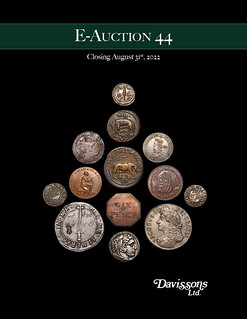
PREV ARTICLE
NEXT ARTICLE
FULL ISSUE
PREV FULL ISSUE
V25 2022 INDEX E-SYLUM ARCHIVE DAVISSON'S E-AUCTION 44In an email to clients on July 28, 2022, Allan Davisson published this overview of his firm's upcoming sale, reflecting on the lessons available from centuries of coinage. -Editor
Exchange, making change, storing value—if one wants a simple definition of what coins are for, this comes close. In ancient times gold was highly valued and sought after and was an important metal for trade. But trading with gold was a complex process. Traders in gold had to have balance scales when calculating payment. But weight alone was not adequate. Purity was a critical issue too. Traders had to have a touchstone—a black stone like jasper—as well as sets of touch needles. The bit of gold offered in trade was rubbed on the touchstone and the scrape was compared to a needle from a set. A ring of needles typically had 24 needles ranging from one part gold to 23 parts of the alloy all the way to a needle of pure gold. Traders had three sets of needles—gold and copper, gold and silver and gold combined with the other two metals. The Lydians are credited with first marking lumps of electrum that had been tested. Electrum was a naturally occurring combination of gold and silver found in river beds and Lydian traders began marking the lumps that had been tested so that the process would not have to be repeated. Croesus, the last of the Lydian dynasts, is credited with standardizing these lumps somewhere around 550 B.C.E. His pieces were created to a standard so that values of each were equal. It took little time for this concept to spread and soon Greek cities adopted standards and began issuing coins. We are still not that far removed from Croesus' idea. While we have expanded the meaning of money and we can make exchanges without physical coins, the US Mint still produces nearly 15 billion coins per year. In looking over everything we are offering in this catalog I began thinking about the evolution of coins and coin manufacture—from hand struck bits of metal to machine struck, pretty much little more than a two-stage process of development. The catalog begins with some gold with an emphasis on late 19th century Europe (plus a bit more). For ancient Greece, there are some appealing silver pieces like the wrestlers of Aspendos, some tetradrachms from Seleukos I, one of the successors who took over part of Alexander the Great's kingdom, a shekel of Tyre, as well as a run of Greek bronzes—simpler coins more likely to be used in the daily lives of the average citizen. Roman coins were closely tied to the ruler who issued them. The emperor's image on the obverse and a message or even a bit of propaganda on the reverse tied this coinage to an individual while Greek coinage was more often tied to a place. Greek bronze and the Imperial Greek bronze that reflected Roman control of Greek places was the common person's currency and it was used at the time and not generally preserved or treated well by the centuries. This set of coinage standards and purposes continued and carried through after the Romans, and coinage as an exchange and as a store of value continued little changed on a fundamental level until the emergence of modern banking. It is this history that is presented in most of our catalogs—bits and pieces from all these eras. And we also offer offshoots—tokens that began as private efforts to create means of exchange when the government failed to mint enough coins, chunks of new world silver stamped with the names of Spanish kings, trade coins designed for use outside the countries of origin…. While working on this catalog, this spring and summer we have also been cataloging a major collection that has one of the most comprehensive collections of Anglo-Saxon coins we have handled. (Look for an introductory section in our next E-Auction and it will anchor our major early 2023 feature auction.) While I have been particularly impressed with this group of thrymsas and sceats and pennies, I have also been fascinated by the range of other things this advanced collector pursued. He and I used to talk about coins and collecting and fascination with the breadth of what numismatics offers. There is a certain satisfaction in building a focused collection but there is also a satisfaction in exploring the variety of intriguing coins that mankind has produced through history. This catalog offers a wide range of things along with some consignments that have a specific focus—a collection of English sixpences, the first section of a collection of English crowns and US dollars, a small collection of British silver tokens from the 1811-1812 series, a few rare Scottish farthings along with many high grade 18th century tokens, a few Spanish American pieces including a couple of pieces from Carlos and Johanna and the 16th century, and more. For me, one of the great pleasures of handling material consigned to us is the opportunity to learn something new and even to buy a new book or two exploring a new path.
For more information, see:
THE BOOK BAZARREWayne Homren, Editor The Numismatic Bibliomania Society is a non-profit organization promoting numismatic literature. See our web site at coinbooks.org. To submit items for publication in The E-Sylum, write to the Editor at this address: whomren@gmail.com To subscribe go to: https://my.binhost.com/lists/listinfo/esylum All Rights Reserved. NBS Home Page Contact the NBS webmaster 
|
